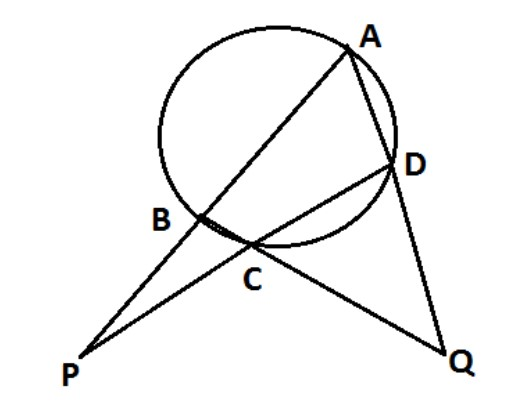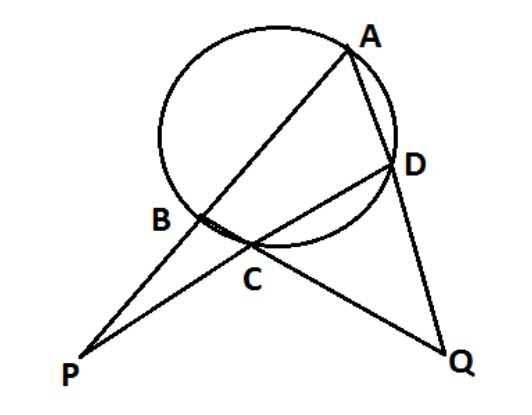
In the given figure , $\dfrac{x}{3} = \dfrac{y}{4} = \dfrac{z}{5}$ ,where $\angle DCQ = x$ , $\angle BPC = y$ and $\angle DQC = z$ , then the value of $x,y,z$ respectively .

A ${33^\circ },{44^\circ }{\text{and 5}}{{\text{5}}^\circ }$
B ${36^\circ },{48^\circ }{\text{and 6}}{{\text{0}}^\circ }$
C ${39^\circ },{52^\circ }{\text{and 6}}{{\text{5}}^\circ }$
D ${42^\circ },{56^\circ }{\text{and 7}}{{\text{0}}^\circ }$

Answer
574.2k+ views
Hint:First let us suppose that the $\dfrac{x}{3} = \dfrac{y}{4} = \dfrac{z}{5} = k$ then $x = 3k,y = 4k,z = 5k$ now try to find out $\angle $DAB and $\angle $ADC , As we know that the sum opposite angle of triangle is ${180^\circ }$ from this property we will find out $\angle $DAB in term of x and we know that the sum two angles of triangle is equal to the exterior angle of third angle from this property find out $\angle $ADC in term $x,y,z$ . At last in triangle APD we know that the sum of the interior angles of the triangle is ${180^\circ }$. From here you will find $x,y,z$ put it in terms of k and get k .Therefore , $\angle $APD $ + $ $\angle $ADP $ + $ $\angle $DAP = ${180^\circ }$.
Complete step-by-step answer:

It is given in the question that $\angle DCQ = x$ , $\angle BPC = y$ and $\angle DQC = z$
First let us suppose that the $\dfrac{x}{3} = \dfrac{y}{4} = \dfrac{z}{5} = k$ then ,
$\dfrac{x}{3} = k$ $\dfrac{y}{4} = k$ $\dfrac{z}{5} = k$
Hence
$x = 3k,y = 4k,z = 5k$
As we know that the BP is straight line hence
$\angle $ BCD $ + $ $\angle $DCQ = ${180^\circ }$
Hence $\angle $BCD = ${180^\circ } - \angle DCQ$
It is given in the question that $\angle $DCQ =$x$ therefore ,
$\angle $BCD = ${180^\circ } - x$
Now in quadrilateral ABCD , it is cyclic quadrilateral hence the sum of opposite angle will be ${180^\circ }$
Therefore ,
$\angle $BCD $ + $ $\angle $DAB = ${180^\circ }$
As we above that the $\angle $BCD = ${180^\circ } - x$ hence on putting this value in above equation we get ,
${180^\circ } - x$ $ + $ $\angle $DAB = ${180^\circ }$
As ${180^\circ }$ is common hence it will cancel out so the remaining equation become ,
$\angle $DAB = $x$
Now in a triangle DQC , we know the property of a triangle that the sum of two angles of the triangle is equal to the exterior angle of the third angle .
So in Triangle DQC
$\angle $DCQ $ + $ $\angle $DQC = $\angle $CDA
As it is given in question that $\angle DCQ = x$ and $\angle DQC = z$
$\angle $CDA = $x + z$
Now in triangle APD we know that the sum of the interior angle of the triangle is ${180^\circ }$ .
Therefore ,
$\angle $APD $ + $ $\angle $ADP $ + $ $\angle $DAP = ${180^\circ }$
It is given that $\angle $APD = $y$
From above we proved that $\angle $APD = $\angle $CDA = $x + z$
and $\angle $DAP = $\angle $DAB = $x$
Now putting these values in the above equation
$y + x + z + x = {180^\circ }$
we know that $x = 3k,y = 4k,z = 5k$ by putting these values in the equation ,
$4k + 3k + 5k + 3k = {180^\circ }$
$15k = {180^\circ }$
Hence $k = 12$
Therefore $x = 3k,y = 4k,z = 5k$
$x = 3 \times 12,y = 4 \times 12,z = 5 \times 12$
$x = {36^\circ },y = {48^\circ },z = {60^\circ }$
So, the correct answer is “Option B”.
Note:One important theorem of cyclic quadrilateral is that The ratio between the diagonals and the sides can be defined and is known as Cyclic quadrilateral theorem. If there’s a quadrilateral which is inscribed in a circle, then the product of the diagonals is equal to the sum of the product of its two pairs of opposite sides.
Complete step-by-step answer:

It is given in the question that $\angle DCQ = x$ , $\angle BPC = y$ and $\angle DQC = z$
First let us suppose that the $\dfrac{x}{3} = \dfrac{y}{4} = \dfrac{z}{5} = k$ then ,
$\dfrac{x}{3} = k$ $\dfrac{y}{4} = k$ $\dfrac{z}{5} = k$
Hence
$x = 3k,y = 4k,z = 5k$
As we know that the BP is straight line hence
$\angle $ BCD $ + $ $\angle $DCQ = ${180^\circ }$
Hence $\angle $BCD = ${180^\circ } - \angle DCQ$
It is given in the question that $\angle $DCQ =$x$ therefore ,
$\angle $BCD = ${180^\circ } - x$
Now in quadrilateral ABCD , it is cyclic quadrilateral hence the sum of opposite angle will be ${180^\circ }$
Therefore ,
$\angle $BCD $ + $ $\angle $DAB = ${180^\circ }$
As we above that the $\angle $BCD = ${180^\circ } - x$ hence on putting this value in above equation we get ,
${180^\circ } - x$ $ + $ $\angle $DAB = ${180^\circ }$
As ${180^\circ }$ is common hence it will cancel out so the remaining equation become ,
$\angle $DAB = $x$
Now in a triangle DQC , we know the property of a triangle that the sum of two angles of the triangle is equal to the exterior angle of the third angle .
So in Triangle DQC
$\angle $DCQ $ + $ $\angle $DQC = $\angle $CDA
As it is given in question that $\angle DCQ = x$ and $\angle DQC = z$
$\angle $CDA = $x + z$
Now in triangle APD we know that the sum of the interior angle of the triangle is ${180^\circ }$ .
Therefore ,
$\angle $APD $ + $ $\angle $ADP $ + $ $\angle $DAP = ${180^\circ }$
It is given that $\angle $APD = $y$
From above we proved that $\angle $APD = $\angle $CDA = $x + z$
and $\angle $DAP = $\angle $DAB = $x$
Now putting these values in the above equation
$y + x + z + x = {180^\circ }$
we know that $x = 3k,y = 4k,z = 5k$ by putting these values in the equation ,
$4k + 3k + 5k + 3k = {180^\circ }$
$15k = {180^\circ }$
Hence $k = 12$
Therefore $x = 3k,y = 4k,z = 5k$
$x = 3 \times 12,y = 4 \times 12,z = 5 \times 12$
$x = {36^\circ },y = {48^\circ },z = {60^\circ }$
So, the correct answer is “Option B”.
Note:One important theorem of cyclic quadrilateral is that The ratio between the diagonals and the sides can be defined and is known as Cyclic quadrilateral theorem. If there’s a quadrilateral which is inscribed in a circle, then the product of the diagonals is equal to the sum of the product of its two pairs of opposite sides.
Recently Updated Pages
Why are manures considered better than fertilizers class 11 biology CBSE

Find the coordinates of the midpoint of the line segment class 11 maths CBSE

Distinguish between static friction limiting friction class 11 physics CBSE

The Chairman of the constituent Assembly was A Jawaharlal class 11 social science CBSE

The first National Commission on Labour NCL submitted class 11 social science CBSE

Number of all subshell of n + l 7 is A 4 B 5 C 6 D class 11 chemistry CBSE

Trending doubts
What is meant by exothermic and endothermic reactions class 11 chemistry CBSE

10 examples of friction in our daily life

One Metric ton is equal to kg A 10000 B 1000 C 100 class 11 physics CBSE

1 Quintal is equal to a 110 kg b 10 kg c 100kg d 1000 class 11 physics CBSE

Difference Between Prokaryotic Cells and Eukaryotic Cells

What are Quantum numbers Explain the quantum number class 11 chemistry CBSE




